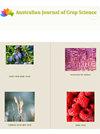Interaction between mycorrhizal fungi and Meloidogyne javanica on the growth and essential oil composition of basil (Ocimum basilicum)
Q3 Agricultural and Biological Sciences
引用次数: 1
Abstract
Plant-parasitic nematodes and arbuscular mycorrhizal fungi (AMF) have been reported to alter the yield and chemical composition of basil (Ocimum basilicum) essential oil. The aim of this study was to evaluate the effectiveness of AMF to control the root-knot nematode Meloidogyne javanica in basil and to investigate the effects of nematode-AMF interactions on plant growth, phosphorus (P) absorption, and essential oil composition. The experiment was conducted under greenhouse conditions following a completely randomized 3 × 2 factorial (two fungal species and an uninoculated control × inoculated and uninoculated seedlings) arrangement with 10 replicates. Substrates were inoculated with Claroideoglomus etunicatum, Rhizophagus clarus, or no fungi (control) and sown with basil seeds. After 20 days, half of the seedlings were inoculated with 4,000 M. javanica eggs. After 60 days, the vegetative parameters, P absorption, essential oil composition, nematode population density, AMF root-colonization efficiency, and AMF spore density were determined. The presence of AMF increased the basil’s fresh weight and ability to absorb P, while reducing the M. javanica reproduction. In total, 21 compounds were identified in basil essential oil, the concentrations of which varied according to the treatments. The major components were eucalyptol, linalool, eugenol, β-elemene, trans-α-bergamotene, and τ-cadinol. Inoculation with AMF decreased the linalool levels but increased the amount of eucalyptol. Mycorrhizal plants showed increased shoot height, P uptake, and essential oil yield and a decreased nematode population density in their roots.菌根真菌与爪哇曲霉对罗勒生长及精油成分的相互作用
据报道,植物寄生线虫和丛枝菌根真菌(AMF)会改变罗勒(Ocimum basilicum)精油的产量和化学成分。本研究旨在评价AMF对罗勒根结线虫爪哇根结线虫的防治效果,并探讨线虫-AMF相互作用对罗勒植株生长、磷吸收和挥发油成分的影响。试验在温室条件下进行,采用完全随机的3 × 2因子(两种真菌和一种未接种对照×接种和未接种幼苗)布置,共10个重复。在基质上分别接种有异齿云母(Claroideoglomus etunicatum)、根噬菌(Rhizophagus clarus clarus)或不接种真菌(对照),并播种罗勒种子。20天后,一半的幼苗接种了4000个爪哇栗豆卵。60 d后,测定真菌的营养参数、磷吸收、精油成分、线虫种群密度、真菌定植效率和真菌孢子密度。AMF的存在增加了罗勒鲜重和吸收磷的能力,同时减少了爪哇支原体的繁殖。在罗勒精油中共鉴定出21种化合物,其浓度随处理的不同而变化。主要成分为桉油醇、芳樟醇、丁香酚、β-榄香烯、反式α-佛手柑烯和τ-二醇。接种AMF降低了芳樟醇的含量,但增加了桉树醇的含量。菌根植物的茎高、吸磷量和挥发油产量增加,根系线虫种群密度降低。
本文章由计算机程序翻译,如有差异,请以英文原文为准。
求助全文
约1分钟内获得全文
求助全文
来源期刊

Australian Journal of Crop Science
农林科学-农艺学
CiteScore
1.20
自引率
0.00%
发文量
75
审稿时长
3.5 months
期刊介绍:
Information not localized
 求助内容:
求助内容: 应助结果提醒方式:
应助结果提醒方式:


